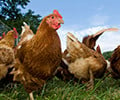The cage-free revolution
As published in Poultry Bulletin – March 2017 Part 1: In this two-part article I will first outline what has taken place in the cage-free environment around the world during the last few years. In the second article, I will discuss some of the options available to South African producers.

Painting the picture
McDonald’s September 2015 decision to transition to eggs reared in cage-free facilities is viewed by many industry commentators as a defining moment for the global egg industry. The company, which serves two billion eggs per year in the US alone, announced its commitment to cease using eggs from hens housed in conventional cages by 2025. Following the announcement, a cascade of food industry corporations pledged to follow suit. In early 2016, the number of companies promising to source cage-free eggs increased exponentially. By April, close to 50 grocery chains and a further 40 restaurant chains had promised changes to their buying policies and, in May alone, a further 30 US companies moved to align their companies with industry sentiment, along with food service and cruise companies (WattAgNet).
Sysco Corps, the world’s largest foodservice distributor, has committed to sourcing only cage-free eggs across its entire US supply chain by 2026. With sales of $48.7 billion in 2015, the company is bigger than McDonalds and adds considerable weight to the movement away from battery farming (ecowatch.com). Walt Disney pledged to use only cage-free eggs in its parks and on its cruise ships by the end of 2016, pushing other corporations to fast-track their own transitions. For those seeking local relevance, multinational retail corporation Walmart (Makro/Game/Jumbo Cash & Carry) announced in April that it would make the transition in its US operations by 2025, whilst Nestlé has now promised to completely overhaul their US egg supply chain within the next five years. Kellogg’s and Unilever have also signed pledges.
Assessing welfare issues
Farm animal welfare is an emotive issue but there are proven means of assessing welfare issues sensibly. Much progress has been made since the 1960’s (when opposition to intensive farming methods was first raised) in developing objective, scientific means of assessing welfare in birds. A hen’s welfare might be described in terms of the following factors: behaviour, disease, stress, foot and skeletal health, parasitic/pest load, nutrition and affective states (such as fear, pain, frustration) (Lay et al., 2011). Animal rights protesters have focused strongly on natural behaviours, affective states and skeletal issues and continue to be very vocal in their opposition to large-scale farming practices; sometimes ignoring objective welfare science. Producers should, however, not delude themselves – conventional cages are difficult to justify on any grounds other than cost-effectiveness and disease control.
Limiting behaviour
Peer-reviewed scientific research has demonstrated that conventional cage systems deny birds the opportunity to exhibit a number of key behaviours which are fundamental to their welfare; resulting in increased levels of frustration, pain and stress. These important behaviours include the opportunity to build a nest, preen, stretch and flap their wings, perch and dust-bathe. Chickens experiencing environmental conditions that deny them important inherent behaviours attempt to find ways to cope in these environments. Their behaviour then takes on abnormal patterns, becoming directed towards self or against cage mates and including such problems as feather pecking, cannibalism or other stereotypic behaviours.
The EU has officially recognised since 1999 that the prevention of several natural behaviours in laying hens is a serious welfare issue and banned the use of battery cages from 2012. Thus, it took half a century between recognition of the problem (Brambell Report, 1965) and the legislative response. A huge volume of objective scientific research into hen welfare was conducted in the interim and continues today.
Cage problems
Besides behavioural issues, conventional cages can cause higher levels of hyperkeratosis in the bird’s feet and, where management is poor and cage doors small, higher levels of new bone breaks during depopulation; exacerbated by brittle bones resulting from lack of exercise and absence of perching behaviour (osteoporosis). Infestations with certain mites and lice may occur because of the housing of large numbers of birds in close proximity and space limitations prevent the birds from using normal grooming procedures to control these infestations.
Advantages
Of course, there are some advantages to conventional systems, even for the birds. Birds are removed from their faeces and soil and are thus protected from a number of disease, parasite and pest challenges. Mortality in conventional cages is less than in barn and free-range systems (but still higher than in enriched cage systems). There is also less dust and thus lower respiratory problems in conventional cages than in aviary and barn systems, and air-borne bacterial infection rates are lower. It is easy to supply cage-housed hens with high quality nutrition and clean water.
Enriched cages
Enriched (furnished) or colony caged systems, now used extensively in the EU, allow birds to exhibit a wider range of their natural behaviours. These systems allow the bird additional space, an opportunity to perch, a nest and a litter bathing area. There remain limitations in terms of space to flap wings and to walk or run around, but the benefits of conventional cages in terms of disease and dust control and high stocking densities are retained. Perches confer benefits in terms of bone strength, providing they are positioned in a way which avoids landing failures. Non-cage facilities, such as aviary systems, barns or free-range systems, offer more complex environments to the birds and allow them to express a fuller range of inherent behaviours and to make social and thermal choices. These increased freedoms can, under poorer management conditions, be accompanied by welfare issues, such as feather pecking, cannibalism, predation, poor air quality, bacterial diseases, parasite and pest infestations, more serious foot problems and the need for beak trimming.
Cost vs welfare
There has been a tendency amongst producers to argue that cost-effectiveness and disease control make caged systems the only viable production system in a hungry world but this argument ignores half a century of thorough research into laying hen welfare and thus plays into the hands of the animal right activists. Alternative systems, poorly managed, may have higher mortalities, cannibalism, feather pecking, floor eggs, dust problems, etc. but it is almost always possible to alleviate these problems through improved management or breeding, and clever implementation of the thousands of scientific findings available in the literature. With conventional cages, it is clear that no amount of improved management can compensate for the welfare issues inherent in the system. Scientifically, producers are on shaky ground if we try to defend our production system as humane.
The need for change
The egg industry boasts one of the world’s most complete and easily marketable products. It is healthy, natural, nutritious and versatile. It can be eaten as is, or included in any number of value-added products. It is an internationally accepted product and is utilised by all age groups, genders, religions and cultures. As an industry, we should have no problem selling unlimited quantities of this incredible offering and yet per capita egg consumption in South Africa is perhaps half of what it might be. Many other countries around the world also have the scope to increase their consumption of eggs to the levels seen in Japan, China and Mexico. In the last few years, the cholesterol concerns which have dogged egg sales and consumption for decades have been dispelled by scientific research. So what might stand in the way of egg sales rocketing in South Africa and around the world? Simple - welfare issues.
The egg industry’s wholesome image, and our opportunities for advertising and promotion, is adversely affected by four ticking time-bombs – caged production, the disposal of male chicks, beak trimming and the treatment of spent hens. All of these concerns are being addressed by producers and governments in the EU and the US at the moment. Hen welfare is rapidly becoming a “horizon issue” for South African producers – an issue which could have profound consequences for producers if we do not recognise it, evaluate it and respond to it, effectively, in time. The speed with which major US and UK corporations have announced their commitment to cage-free production has demonstrated how quickly a shift can be imposed on an industry that has not paid enough attention to the external landscape. A sample of US egg producers (housing over 125 million hens) changed their forecast of what proportion of hens would be in non-caged systems in 2025 from 13.7 %, when asked in 2014, to 40.6 %, when asked the same question in 2015; such is the speed with which the industry is being forced to change (Top Egg Companies Survey, WattAgNet).
